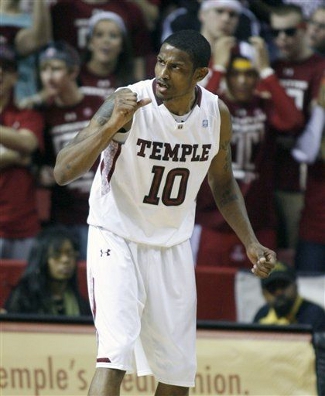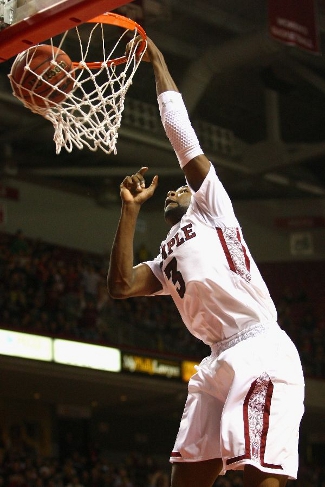Frank Erwin Center | Austin, TX | Tip: 1:30 P.M. CT | TV: ESPN2 LRT Consecutive Game #197 Although Selection Sunday is still three months away, the Longhorns could be putting their tournament hopes on the line this afternoon. In the latest projection from ESPN’s resident bracketologist, Joe Lundardi, Texas was one of the first four teams out of the field, a result of a weak non-conference schedule that included a pair of losses against the only two quality teams on it. Today, Texas kicks off the truly challenging part of its schedule, hosting Temple before heading to North Carolina and then opening conference play a week later. If the Longhorns are going to make the Big Dance this season, they will have to win their home games against other tournament teams like Temple.
Ramon Moore leads an experienced Temple team By the Numbers The Owls aren’t a flashy, exciting bunch, but they are well-coached and well-disciplined. In past seasons under Fran Dunphy, Temple has checked in as part of the bottom third in D-I hoops when it comes to tempo. This season, they’ve sped it up a little, but still only average 67 possessions per game, just off the national average of 67.3 possessions. On offense, Temple is one of the most efficient teams in the land. They score 1.103 points per possession, the 25th-best mark in the country. The Owls do this by being patient and taking smart shots, which has led to a 52.5% effective field goal mark. That methodical approach also helps to protect the ball, as the Owls turn it over on less than 20% of their possessions. Defensively, Temple likes to sit back in a man defense reminiscent of the pack-line defense. While there is less pressure on perimeter ballhandlers, the Owls certainly sag off on D, daring opponents to shoot. So far, it’s been very successful this season, with Temple opponents having an effective field goal percentage of 47.1%, below the national average. The Owls have been hurt by a late-November injury to big man Micheal Eric (No. 50), so in recent games, opponents have been able to find more success once they get the ball inside. Meet the Owls Without Eric and with senior Scootie Randall (No. 33) working his way back from a torn meniscus, the Temple rotation is very thin. They are essentially running a seven-man rotation, with only one player — 6’9″ redshirt freshman Anthony Lee (No. 3) — checking in over 6-feet, 6-inches. Although the Owls have lost a lot of size without Eric, they still have a very tall, experienced backcourt. The steady ballhandler is 6’4″ Juan Fernandez (No. 4), a senior from Argentina who is averaging 12.5 points and 4.1 assists per game. Fernandez uses his size to his advantage, often working smaller guards down the lane before hitting a running floater or a turnaround jumper off the blocks. He’s also just dangerous enough from the outside to keep defenses honest, knocking down 36% of his long-range attempts so far this season. Fernandez looks best from outside when catching the ball in rhythm and stepping into the shot, and he particularly likes to pop it from the right wing. Joining Fernandez in the backcourt is the team’s leading scorer, senior Ramone Moore (No. 10). Moore is a slippery guard who can create his own shot on the dribble. He’s smooth with the ball cutting through traffic, but he seems most comfortable driving and curling to his left. Moore’s averaging more than 18 points per game and actually has more than four rebounds per game. The third member of the guard troika is junior Khalif Wyatt (No. 1), the three-point marksman. Although he’s only made 35.5% of his shots behind the arc this season, he has range well past the NBA line and made more than 42% of his threes as a sophomore. He’s also an adept ballhandler, and can take over at the point when Fernandez needs a breather or is in foul trouble. On the wing, junior Rahlir Hollis-Jefferson (No. 32) is a great rebounder and shot blocker. He also added a mindrange jumper to the repertoire this offseason, and it’s keeping defenses more honest. While Hollis-Jefferson isn’t always knocking that shot down from the opening tip, he’s more than willing to take it.
Injuries have forced Anthony Lee into a bigger role With Eric out of the lineup, redshirt freshman Lee has been thrust into the starting five. He sat out last season with a herniated disk in his back, but had a great summer and is averaging nearly seven boards per game to go with five points. He’s not yet a post-up player, but he’s athletic and very active inside, so he cleans up the garbage and makes those all-important hustle plays. Off the bench, sophomore guard Aaron Brown (No. 22) is playing roughly 14 minutes per game after starting the last nine games of his freshman campaign due to Randall’s injury issues. He has been the team’s most-consistent outside shooter so far, knocking down nearly 46% of his threes. On a team that can often go cold from outside, that kind of success rate truly stands out. The final healthy member of the Temple rotation is 6’3″ T.J. DiLeo (No. 11). While he doesn’t stuff the stat sheet, DiLeo is a very scrappy player on defense, and is often found on the floor in the scramble for loose balls. He’s actually very quick with the dribble, but typically passes it off when he approaches the lane. On the season, DiLeo has attempted only 17 shots despite appearing in every game and averaging nearly 20 minutes. Keys to the Game 1) Knock down shots – This would seem to be a fairly simple instruction, one that would be key to winning just about any basketball game. Make your shots, win the game. But against Temple, it’s even more important that Texas drill the looks they are given. The Owls are going to sit back on defense and force the Longhorns to take jumpers. If Texas can’t even do that, Temple has no reason to adjust their D. But if the Longhorns can prove they will hit jump shots, the Owls have to play a little tighter, the Texas guards can do more on dribble penetration, and the entire offense opens up. 2) Do work on the glass – Without Eric in the lineup, the Owls are similar in size to many of the low-major teams that Texas has faced in recent weeks. Texas can overcome that staunch Temple defense by grabbing offense boards and giving themselves easier second-chance looks inside, while they can stifle that smart, patient Temple offense by dominating on the defensive glass as well. Against a team that skews towards the slower pace of play, the handful of extra shots created or prevented by rebounding can be the difference in the game. 3) Score in transition – The best way to beat a sound defense is to never let it set up in the half court. While Texas doesn’t need to try to turn this into a track meet, the Horns do need to be looking up after Temple misses and trying to score easy points. Even in situations where the fast break isn’t there, pushing the tempo could allow things to open up in the secondary break, especially with the three-point shooters that the Longhorns have on the roster. |










